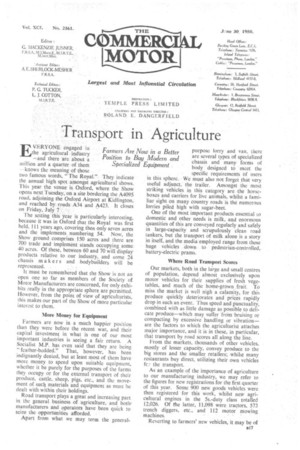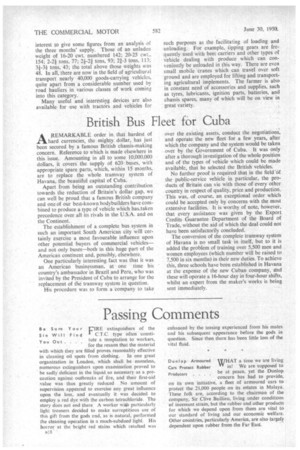Transport in Agriculture
Page 35

Page 36

If you've noticed an error in this article please click here to report it so we can fix it.
EVERYONE engaged in. theagricultural'industry —and there ate, about a million and a quarter of .them --knows the meaning of those . two famous words, "The Royal.". They indicate • the annual -high spot amongst agricultural shows. This year the venue' is .Oxford, where the Show opens next Tuesday, on .a site bordering the A4095 road, adjoining the' Oxford Airport at Kidlington; and reached by'roads' A34 and A423. It closes on Friday. July 7 The setting this year is particularly interesting, because it was in Oxford that the Royal was first held, 111 years ago, covering then only seven acres and the implements, numbering 54. Now, the Show ground. comprises. 150 acres and there are 700 trade and implement stands occupying some 40 acres. Of these, between 60 and 70 will display products relative to our industry, and some 24 chassis makers and bodybuilders will be represented.
It must be remembered that the Show is not an open one so far as members of the Society of Motor Manufacturers are concerned, for only exhibits really in the appropriate sphere are permitted. However, from the point of view of agriculturists, this makes our part of the Show of more particular interest to them.
More Money for Equipment Farmers are now in a much happier position than they were before the recent war, and their capital investment in what is one of our most important industries is seeing a fair return. A Socialist M.P. has even said that they are being "feather-bedded." That, however, has been indignantly denied, but at least most of them have more money to spend upon suitable equipment, whether it be purely for the purposes of the farms they occupy or for the external transport of their produce, cattle,. sheep, pigs, etc., and the movement of such materials and equipment as must be dealt with within their holdings.
Road transport plays a great and increasing part in the general business of .agriculture,' and both manufacturers. and operators have been quick to seize the ,opportunities afforded. • Apart from what we may term the general purpose lorry and van, there are several types of specialized chassis and many forms of body designed to meet the specific requirements Of users in this sphere. We must also not forget that very useful adjunct, the trailer. Amongst the most striking vehicles in this category are the horseboxes and carriers for live animals, whilst a familiar sight on many country roads is the numerous lorries piled high with sugar-beet.
One of the most important products essential to domestic and other needs is milk, and enormous quantities of this are conveyed regularly and safely in large-capacity and scrupulously clean road tankers, but the transport Of milk alone is a story in itself, and the media employed range from these huge vehicles down to pedestrian-controlled, battery-electric prams, Where Road Transport Scores Our markets, both in the large and small centres of population, depend almost exclusively upon motor vehicles for their supplies of fresh vegetables, and much of the home-grown fruit. To miss the market is well nigh a calamity, for this produce quickly deteriorates and prices rapidly drop in such an event. Thus speed and punctuality, combined with as little damage as possible to delicate produce—which may suffer from bruising or compacting by excessive handling or vibration— are the factors to which the agriculturist attaches major importance, and it is in these, in particular, that transport by road scores all along the line.
From the markets, thousands of other vehicles, mostly of lesser capacity, convey produce to the big stores and the smaller retailers; whilst many restaurants buy direct, utilizing their own vehicles fclthe transport.
As an example.of the importance of agriculture to our manufacturing industry, we may refer to the figures for new registrations for the first quarter of this year. Some 900 new goods vehicles were then registered for this work, whilst new agriCultural engines in the 5s.-duty class totalled 12,026. Of the latter, 11,098 were tractors, 573 trench diggers, etc., and 112 motor mowing machines.
Reverting to farmers' new vehicles, it may be of interest to give some figures from an analysis of the three months' supply. Those of an unladen weight of 16-20 cwt. numbered 142; 20-25 cwt., 154; 2-21 tons, 77; 2+-2/ tons, 93; 2/-3 tons, 113; 3+-31 tons, 43; the total above those weights was 48. In all, there are now in the field of agricultural transport nearly 40,000 goods-carrying vehicles, quite apart from a considerable number used by road hauliers in various classes of work coming into this category.
Many useful and interesting devices are also available for use with tractors and vehicles for such purposes as the facilitating of loading and unloading. For example, tipping gears are frequently used with beet carriers and other types of vehicle dealing with produce which can conveniently be unloaded in this way. There are ev.:it small mobile cranes which can travel over soft ground and are employed for lifting and transporting agricultural implements. The farmer is also in constant need of accessories and supplies, such as tyres, lubricants, ignition parts, batteries, and chassis spares, many of which will be on view in great variety.




























































































































